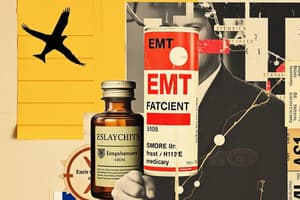Podcast
Questions and Answers
A medication with antagonistic properties is one that:
A medication with antagonistic properties is one that:
- Stimulates receptor sites and allows other chemicals to attach to them.
- Blocks receptor sites and prevents other chemicals from attaching to them. (correct)
- Enhances the effects of another medication when given in a higher dose.
- Produces a cumulative effect when mixed with the same type of medication.
Which of these medications can be obtained over-the-counter (OTC)?
Which of these medications can be obtained over-the-counter (OTC)?
- Isordil
- Digoxin
- Nexium (correct)
- Lasix
After assisting a patient with her prescribed MDI during an acute asthma attack, you should:
After assisting a patient with her prescribed MDI during an acute asthma attack, you should:
- Administer another treatment in 30 seconds if she is still in distress.
- Reassess the patient and document her response to the medication. (correct)
- Check the drug's expiration date to ensure that it is still current.
- Contact medical control and apprise him or her of what you did.
How is nitroglycerin usually given by the EMT?
How is nitroglycerin usually given by the EMT?
After confirming the drug's name and expiration date from the epinephrine auto-injector, you should:
After confirming the drug's name and expiration date from the epinephrine auto-injector, you should:
Which of the following is an example of a rules-based medication error?
Which of the following is an example of a rules-based medication error?
The EMT should suspect that a patient has overdosed on an opioid drug when:
The EMT should suspect that a patient has overdosed on an opioid drug when:
Advil, Nuprin, and Motrin are trade (brand) names for the generic medication:
Advil, Nuprin, and Motrin are trade (brand) names for the generic medication:
While assisting a paramedic in the attempted resuscitation of a cardiac arrest patient, you should expect the paramedic to:
While assisting a paramedic in the attempted resuscitation of a cardiac arrest patient, you should expect the paramedic to:
When treating a middle-aged man with chest discomfort and a history of heart attacks, you should:
When treating a middle-aged man with chest discomfort and a history of heart attacks, you should:
A 62-year-old male experiencing crushing chest pain has prescribed nitroglycerin. You should:
A 62-year-old male experiencing crushing chest pain has prescribed nitroglycerin. You should:
An EMT may administer aspirin to a patient if:
An EMT may administer aspirin to a patient if:
Aspirin is beneficial to patients suspected of having a heart attack because it:
Aspirin is beneficial to patients suspected of having a heart attack because it:
In ___________ administration, you are administering medication to yourself or your partner.
In ___________ administration, you are administering medication to yourself or your partner.
Nitroglycerin, when given to patients with cardiac-related chest pain:
Nitroglycerin, when given to patients with cardiac-related chest pain:
Separation is especially an issue with medicine used as a(n):
Separation is especially an issue with medicine used as a(n):
The __________ of a medication usually dictates the route by which it will be administered.
The __________ of a medication usually dictates the route by which it will be administered.
The medical term for a low blood glucose level is:
The medical term for a low blood glucose level is:
The process by which medications travel through body tissues until they reach the bloodstream is called:
The process by which medications travel through body tissues until they reach the bloodstream is called:
The term 'pharmacology' is MOST accurately defined as:
The term 'pharmacology' is MOST accurately defined as:
What medication form does oral glucose come in?
What medication form does oral glucose come in?
The medications atorvastatin (Lipitor) and amlodipine (Norvasc) suggest a history of:
The medications atorvastatin (Lipitor) and amlodipine (Norvasc) suggest a history of:
Which of the following is an example of a generic drug?
Which of the following is an example of a generic drug?
Which of the following medication routes delivers a drug through the skin over an extended period, such as a nitroglycerin or fentanyl patch?
Which of the following medication routes delivers a drug through the skin over an extended period, such as a nitroglycerin or fentanyl patch?
Which of the following statements regarding glucose is correct?
Which of the following statements regarding glucose is correct?
Which of the following statements regarding parenteral medications is correct?
Which of the following statements regarding parenteral medications is correct?
Which of the following statements regarding the epinephrine auto-injector is correct?
Which of the following statements regarding the epinephrine auto-injector is correct?
Which of the following statements regarding the metered-dose inhaler (MDI) is correct?
Which of the following statements regarding the metered-dose inhaler (MDI) is correct?
With the flowmeter set at 6 L/min, the nasal cannula will deliver up to _______ oxygen.
With the flowmeter set at 6 L/min, the nasal cannula will deliver up to _______ oxygen.
In treating a 45-year-old woman stung by a hornet, if you are not able to make contact with medical control, you should:
In treating a 45-year-old woman stung by a hornet, if you are not able to make contact with medical control, you should:
Flashcards
Antagonistic Medications
Antagonistic Medications
Medications that prevent other chemicals from attaching to receptor sites.
Over-the-Counter (OTC)
Over-the-Counter (OTC)
A type of medication that is available without a prescription.
Metered-Dose Inhaler (MDI)
Metered-Dose Inhaler (MDI)
A device used to deliver a measured dose of medication, typically in an inhaled form.
Reassessment
Reassessment
Signup and view all the flashcards
Nitroglycerin
Nitroglycerin
Signup and view all the flashcards
Sublingual Administration
Sublingual Administration
Signup and view all the flashcards
Anaphylaxis
Anaphylaxis
Signup and view all the flashcards
Epinephrine
Epinephrine
Signup and view all the flashcards
Rules-Based Medication Error
Rules-Based Medication Error
Signup and view all the flashcards
Naloxone (Narcan)
Naloxone (Narcan)
Signup and view all the flashcards
Opioid Overdose Signs
Opioid Overdose Signs
Signup and view all the flashcards
Ibuprofen
Ibuprofen
Signup and view all the flashcards
Generic Drug
Generic Drug
Signup and view all the flashcards
Medical Control Authorization
Medical Control Authorization
Signup and view all the flashcards
Allergy Confirmation
Allergy Confirmation
Signup and view all the flashcards
Hypoglycemia
Hypoglycemia
Signup and view all the flashcards
Medication Absorption
Medication Absorption
Signup and view all the flashcards
Enteral Medication
Enteral Medication
Signup and view all the flashcards
Parenteral Medication
Parenteral Medication
Signup and view all the flashcards
Oral Glucose Gel
Oral Glucose Gel
Signup and view all the flashcards
Epinephrine Auto-Injector (EpiPen)
Epinephrine Auto-Injector (EpiPen)
Signup and view all the flashcards
Subcutaneous Route
Subcutaneous Route
Signup and view all the flashcards
Metered-Dose Inhaler (MDI)
Metered-Dose Inhaler (MDI)
Signup and view all the flashcards
Nasal Cannula
Nasal Cannula
Signup and view all the flashcards
Oxygen Concentration
Oxygen Concentration
Signup and view all the flashcards
Continuous Monitoring
Continuous Monitoring
Signup and view all the flashcards
Transport and Monitoring
Transport and Monitoring
Signup and view all the flashcards
Study Notes
Medication Properties
- Medications with antagonistic properties block receptor sites, preventing other chemicals from attaching.
- Over-the-counter (OTC) medication in the provided list is Nexium.
Asthma Management
- Post-assistance with a metered-dose inhaler (MDI) for an asthmatic patient, reassess and document the patient's response.
Nitroglycerin Administration
- Nitroglycerin is typically administered sublingually.
- In cardiac-related chest pain, relaxes coronary arteries, contributing to pain relief.
Allergic Reactions
- Signs of severe allergic reactions may be treated with epinephrine; medical control should be contacted upon receipt of an auto-injector from the patient.
Medication Errors
- A rules-based medication error occurs when an EMT administers a drug not approved by the medical director.
Opioid Overdose Signs
- Administration of naloxone (Narcan) suggests the patient may have overdosed on an opioid.
Common Medications
- Advil, Nuprin, and Motrin are brand names for ibuprofen.
- Aspirin is an example of a generic drug.
Transport and Treatment Protocols
- EMTs should administer medications cautiously; authorization from medical control is needed for aspirin in specific cases.
- Confirm no allergy before administering aspirin and document related details.
Blood Glucose Levels
- Hypoglycemia is the medical term for low blood glucose levels.
Medication Absorption
- Absorption is the process through which medications travel through tissues into the bloodstream.
Medication Forms
- Oral glucose is available in gel form.
- Parenteral medications are absorbed more quickly than enteral medications.
EpiPen Use and Delivery
- The epinephrine auto-injector delivers a preset amount of medication and is administered via the subcutaneous route.
Metered-Dose Inhalers
- MDIs provide a consistent medication dose with each use.
Oxygen Delivery
- A nasal cannula at a flow rate of 6 L/min can deliver oxygen concentration up to 44%.
Emergency Response
- In cases of allergic reactions with stable vital signs, begin transport while continuously monitoring the patient.
Studying That Suits You
Use AI to generate personalized quizzes and flashcards to suit your learning preferences.




